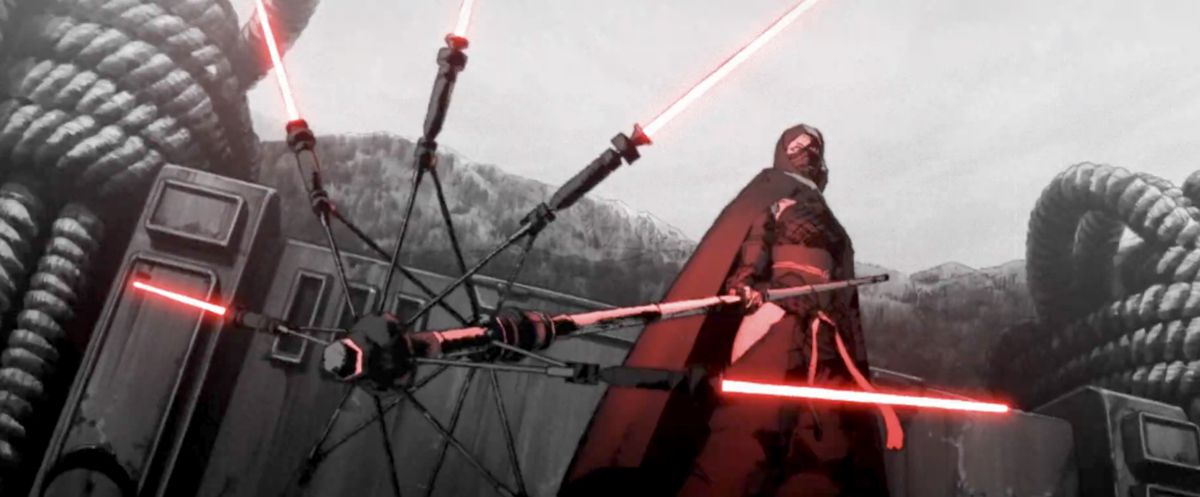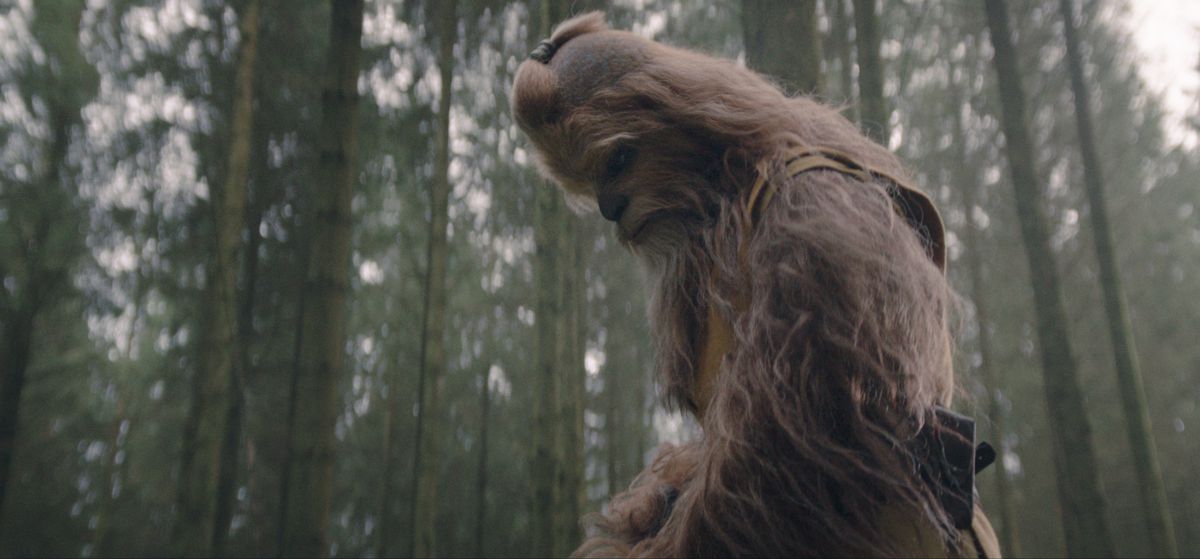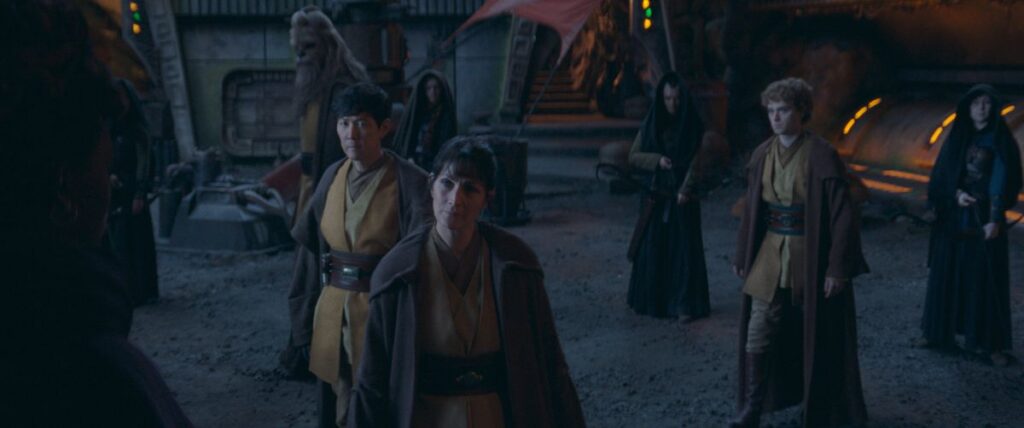The Acolyte is the latest Star Wars series to launch on Disney Plus. Unlike previous series, such as Ahsoka (after Return of the Jedi) and Andor (before A New Hope), it takes place in a unique and largely unexplored era of the Star Wars galaxy (in live action, at least). Created by Leslye Headland, a self-professed major Star Wars fan, and starring Lee Jung-jae, Amandla Stenberg, and Carrie-Anne Moss, The Acolyte is intended to be as new-viewer-friendly as possible.
That said, there are a few questions viewers may have as they head into the two-part series premiere, and we’ve got the answers!
What is the High Republic?
Launched in January 2021, the High Republic began as a sub-franchise publishing initiative from Lucasfilm, told across a variety of short stories, novels, and comic books. Named for the era of in-universe galactic history that marks a relative cultural and political high-water mark for the Republic in general and the Jedi specifically, stories set in the High Republic Era take place anywhere between 500 and 100 years before the events of the nine films that comprise the cinematic Skywalker Saga. For anyone familiar with the Old Republic Era thanks to the series of wildly popular video games set in that era, the High Republic Era falls squarely between that time and the time of the “main” movies.
The stories typically chronicle the conflict between the Jedi and the Nihil, a group of ruthless space pirates who use their arcane knowledge of hyperspace travel to carry out devastating attacks on the Republic. But one of the things that distinguishes the High Republic from similar era-specific publishing efforts is its wide scope. With stories told in everything from books for young readers to YA novels to traditional adult novels, from comic books to audio dramas, there are different tones and flavors for a wide variety of tastes. The Nihil are far from the only threat facing the galaxy, which also includes the Dregnir — a species of carnivorous sentient plants — as well as cults consisting of other non-Jedi Force users. The Jedi dealing with the threat of the Nihil during an era of prosperity forms the narrative backbone of the sub-franchise, but even in the short existence of the High Republic as a storytelling initiative, the sheer volume and breadth of stories released creates a lot of nooks and crannies to explore.
When does The Acolyte take place?
Image: Lucasfilm
The Acolyte represents the first on-screen foray into the High Republic Era. It is also marking the latest point yet in the High Republic Era — that is, the point in time closest to the previously established events of the movies. Specifically, The Acolyte takes place about 100 years before the rise of the Empire, putting it toward the very tail end of the High Republic Era.
That point in the timeline is very much intentional. According to showrunner Leslye Headland, “If Star Wars is about the underdog versus the institution, [in The Acolyte] the Jedi are the institution. I was so interested in a storyline where the Jedi were at the height of their power — and I don’t mean The Phantom Menace, because at that point, there’s a Sith Lord in the Senate that they’re not picking up on.” Headland also expresses a desire to explore “what went wrong” that led the Jedi Order from the highs of the High Republic to the stagnation and ignorance displayed during the prequel trilogy, in which the Jedi are hoodwinked into aiding their own downfall by a threat hiding right under their collective noses.
Setting The Acolyte at the tail end of the Jedi heyday is thus critical to that examination. It allows Headland and her team the closest possible chronological point to the prequels, to draw the most direct line possible from the Jedi at their zenith to the Jedi at their nadir.
It’s also worth noting, to that end, that the Jedi of the High Republic are, in their ways, quite a bit different from the Jedi of the prequel trilogy. Some of the differences are simply aesthetic; in addition to the “typical” look of simple robes not unlike those worn by moisture farmers and desert hermits, the High Republic Jedi also don more resplendent dress robes of shimmering white and gold. Their lightsabers are more ornate (and, occasionally, more whip-like), with pronounced physical hilts, and they are worn in leather holsters rather than simply dangling from belts. Mission attire for High Republic Jedi includes leather gauntlets and armor.
But the differences go deeper than that. While the Jedi of the High Republic still teach about the dangers of attachment, they are less like the celibate monks of the prequel era. Deep friendships exist among the Jedi, and even, in at least one instance, physical intimacy (which is still frowned upon, but no one was drummed out of the Jedi Order over it). The High Republic Jedi also seem to have a deeper understanding of the Force, with certain Jedi dedicating themselves to the exploration of specific aspects of or abilities with the Force, such as battle meditation or the ability to strengthen the Force bonds among a group of Jedi. This can be seen in The Acolyte via Carrie-Anne Moss’ Indara, a Jedi who is proficient in something not unlike Force-aided kung fu.
All of this serves to underscore the difference between the High Republic Jedi and the more familiar Jedi of the Skywalker Saga. Which, in turn, underscores that question Headland is eager to explore, of what caused those differences to emerge in the first place.
What about the Sith? Where are they during the High Republic?

Image: Disney Plus/Lucasfilm
That answer is a bit more… complicated. In The Phantom Menace, Jedi council member Ki-Adi-Mundi (the conehead Jedi) tells Qui-Gon Jinn that the Sith have been extinct “for a millennium.” That would mean there’s no way the Sith could factor into The Acolyte, given it takes place a mere 100 years before Ki-Adi-Mundi made his declaration, well within that millennium. But, of course, Ki-Adi-Mundi is wrong. He’s wrong even before he speaks the words; the audience has already seen Qui-Gon battle Darth Maul on the sands of Tatooine, and the audience already knows Darth Maul is a Sith, even if the Jedi don’t. And, of course, the Sith’s whole deal is the “Rule of Two,” in which a series of masters and apprentices keep the whole Sith show running, specifically from the shadows.
So the door is certainly open for the Sith to appear in The Acolyte (as they seem to in the first two episodes), albeit in a subtle way (that would still lead Ki-Adi-Mundi to make his incorrect declaration and not get laughed out of the council chambers). Headland has likened the Sith in this era to that of a Velociraptor for the Jedi: “Like it’s a thing I’ve heard of, but it’s not a thing that you would ever consider you’d be interacting with.” Whether they are the central antagonists, and, if so, how they manage to maintain their status as extinct beings of myth and legend remains to be seen.
Anything else you need to know?

Image: Lucasfilm
Honestly, not really. Everyone involved has been very insistent that The Acolyte is not a series that requires homework. It is designed for anyone with just a passing familiarity with Star Wars to pick up and enjoy.
One thing worth noting is the presence of Vernestra Rwoh, the only named member of the cast thus far to previously appear in the High Republic. A teen prodigy Jedi, Vernestra made several appearances throughout the publishing line. But like The Acolyte’s setting in the High Republic timeline, her appearance in the series comes later in her own personal timeline, when she is over 100 years old. As a result, while the name will be familiar to High Republic readers, even they will have much to learn about her alongside newcomers.
Also, anyone who has seen Return of the Jedi knows that Yoda is over 900 years old when he dies, which means he’s very much active during the High Republic Era. No word yet, however, whether he’ll appear in The Acolyte.

